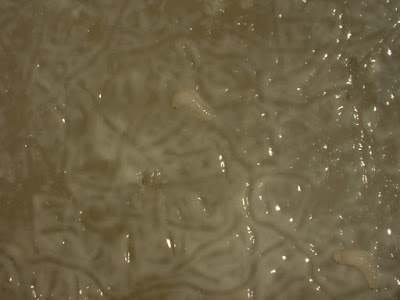What are these objects, and what is their likely source? Were they likely from the pleural fluid, the blood culture media (into which the pleural fluid was inoculated), the agar culture media, or the environment? What steps would you take to figure this out? A special thanks to Felicity for these photos and videos!
Tuesday, September 11, 2018
Case of the Week 510
This week's case is an unexpected finding on a 3-day-old pleural fluid bacterial culture growing on a Mueller-Hinton agar plate. The specimen was from a hospitalized North American adult patient with no travel history.
What are these objects, and what is their likely source? Were they likely from the pleural fluid, the blood culture media (into which the pleural fluid was inoculated), the agar culture media, or the environment? What steps would you take to figure this out? A special thanks to Felicity for these photos and videos!
What are these objects, and what is their likely source? Were they likely from the pleural fluid, the blood culture media (into which the pleural fluid was inoculated), the agar culture media, or the environment? What steps would you take to figure this out? A special thanks to Felicity for these photos and videos!
Subscribe to:
Post Comments (Atom)







8 comments:
That's a very hungry fly larva. Very unlikely that it came from pleural fluid or blood culture media. Could the mother fly have deposited the eggs while the Mueller Hinton plates are poured and left open to cool?
Seal with Masking tape Petri plate to prevent the passage of flies
Conjures up memories of this nursery rhyme..Perhaps an x-ray will reveal additional organisms...
https://www.youtube.com/watch?v=qC_xO2aN_IA
Larves de mouche, provenant de d'environnement.
For sure, a case of "agarmyasis". The fly larvae are devouring the Mueller-Hinton agar. Now we have an "agar screw worm". As far as where do they come from? We can see a few possibilities:
1/ The sheep blood could have been contaminated at the time of collection, the fly's eggs were laid on the sheep prior to collection. This blood could have been refrigerated and thereby, preserved the intact eggs inactive. Since this blood cannot be heat sterilized, and could only be mixed with the sterilized but warm agar, the larvae were still alive. After solidification, the Blood Agar plates were refrigerated thus extend the inactivity of the bugs yet did not kill them. When the bacti culture grew, the microbial growth was seeded onto the Mueller Hinton Agar for sensitivity and the larvae hatch and became active.
2/ The Mueller-Hinton plate at pouring had the lid ajar till the agar solidifies to avoid condensation, the fly could have ovideposited during this period of time. The plate later was refrigerated for preservation till usage, the larvae though inactive, remained alive and revive upon incubation.
I am just curious as to why a Mueller-Hinton agar was incubated for three days since most Kirby-Bauer sensitivities are read between 18-24 hours.
Anyway, a very interesting case with an intriguing enigma.
Florida Fan
Pleural myiasis has been documented in humans. Most cases occur in the tropics under less than hygienic conditions. North American cases are generally caused by a variety of bot flies. The larvae in case 510 do not have the robust morphology of bot larvae. Sarcophagid and Calliphorid have also been found in human pleural fluid, often associated with a cancerous tumor (which may provide access for gravid females flies). Suggest a more complete medical record of the patient and a reexamination of fresh pleural fluid if possible.
I don't think the culture media is at fault since it requires boiling and sterile technique to produce. Contamination of media after creation is possible (I like Dr. Molina's suggestion).
The "chow hound" larvae in culture appear to be of similar size and small, suggesting a common hatch period. The spiracular plates appear to be an early developmental stage perhaps 2nd larval instar. Depending on the species of fly this could be two days or less. Making the larva a post culture contaminant. A more definitive answer could be made if I could ID the Genus, measure the larva, and have a better look at the spiracular plates.
Playing the odds I'll go with contaminant.
This is most-certainly contamination of the agar plate. Flies oviposited/larviposited on the agar (or even the rim of the plate) at some point as it sat around (possibly even the specimen if it sat around, but I am thinking the contamination involved the plate itself at some point). In fact some of the bacteria on the plate may be from the parent flies and/or larva and not necessarily from the clinical specimen.
If the maggots are truly happy to be consuming the agar, it should be straightforward to rear them to an easier-to-identify 3rd instar. Given the likelihood that they are an environmental contaminant and not a medically important species, rearing them all the to adults and sending them to an extension entomologist could be the most effective way to figure out what they are.
- Mark Fox
Post a Comment